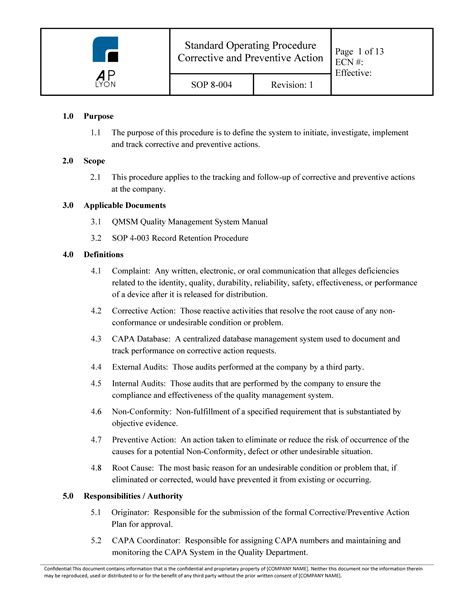Establishing a systematic approach to managing nonconformities, quality issues, and other potential risks is crucial for maintaining quality and meeting regulatory requirements. A well-defined corrective and preventive action (CAPA) procedure template provides a structured framework for organizations to identify, investigate, and address problems, preventing their recurrence and improving overall performance.

Comprehensive CAPA Management
An effective CAPA procedure template outlines the following key steps:
Identification and Documentation: Establish clear criteria for identifying quality issues, nonconformities, and potential risks. Provide a standardized mechanism for documenting and reporting these occurrences.
Root Cause Analysis: Conduct thorough investigations to identify the underlying causes of problems. Utilize root cause analysis techniques to determine the factors that led to the issue and develop effective corrective actions.
Developing and Implementing Corrective Actions: Based on the root cause analysis, implement corrective actions aimed at eliminating the root cause and preventing the recurrence of the problem.
Verification of Effectiveness: Evaluate the effectiveness of the corrective actions implemented to ensure they have resolved the issue and prevented its recurrence.
Continuous Improvement and Prevention
The CAPA process not only focuses on addressing current nonconformities but also emphasizes continuous improvement and prevention. Key elements of a preventive approach include:
Risk Assessment: Conduct regular risk assessments to identify potential areas of concern and develop proactive measures to prevent problems from occurring.
Preventive Actions: Implement proactive actions to mitigate identified risks and prevent future nonconformities.
Trending and Analysis: Regularly review and analyze CAPA reports to identify trends and patterns. Use this information to enhance the CAPA process and identify systemic issues that require attention.
Continuous Monitoring and Review: Establish a system for ongoing monitoring and review of the CAPA process to ensure its effectiveness and identify areas for improvement.
Employee Involvement: Encourage employee involvement in the CAPA process to gather insights from all levels of the organization and foster a culture of continuous improvement.
Conclusion
By implementing a robust corrective and preventive action procedure template, organizations can effectively manage nonconformities, identify and address root causes, and prevent the recurrence of problems. This systematic approach enhances quality, ensures compliance, and promotes continuous improvement, ultimately leading to increased customer satisfaction and organizational success.
Remember that a well-defined CAPA procedure template is not just a set of steps but a vital tool for fostering a culture of quality, innovation, and risk mitigation within the organization.